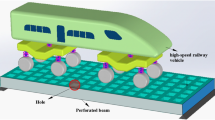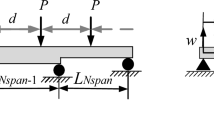Abstract
In this paper, two different numerical methods are presented for the dynamic response of Euler–Bernoulli and Timoshenko beam under the impact of 10-DOF high-speed train (HST). Bridge beam is modeled in simply supported and uniform structure. The train traveling at high and constant speed on the bridge is modeled by taking into consideration primary and secondary suspension systems. The motion equation of the system was obtained using the Hamilton principle. These differential equations have been solved in the time domain using the fourth-order Runge–Kutta algorithm. The motion equations of the system have been converted to finite element format using Galerkin’s weak-form formulation. The finite element solution of the system was solved using the Newmark-β algorithm, and both algorithms were compared. In addition, Timoshenko beam theory and Euler–Bernoulli beam theory presented in the study were compared in terms of both bridge dynamics and train dynamics. As a result, although the speed difference between the two theories is significant at the critical speed values of HST, this difference in certain speed values decreases considerably.










Similar content being viewed by others
References
Timoshenko S (1922) On the forced vibration of bridges. Philos Mag Ser 43:1018
Fryba L (1996) Dynamics of railway bridges, 2nd edn. Thomas Telford House, London
Frýba L (1999) Vibration of solids and structures under moving loads. Vib Solids Struct Under Mov Loads. https://doi.org/10.1680/vosasuml.35393
Timoshenko SP (1953) History of strength of materials: with a brief account of the history of theory of elasticity and theory of structures. McGraw-Hill, New York
Cheung YK, Au FTK, Zheng DY, Cheng YS (1999) Vibration of multi-span non-uniform bridges under moving vehicles and trains by using modified beam vibration functions. J Sound Vib 228:611–628. https://doi.org/10.1006/jsvi.1999.2423
Chu K-H, Garg VK, Dhar CL (1979) Railway-bridge ımpact: simplified train and bridge model
Van Bogaert P (1993) Dynamic response of trains crossing large span double-track bridges. J Constr Steel Res 24:57–74. https://doi.org/10.1016/0143-974X(93)90063-X
Esmailzadeh E, Ghorashi M (1995) Vibration analysis of beams traversed by uniform partially distributed moving masses. J Sound Vib 184:9–17. https://doi.org/10.1006/JSVI.1995.0301
Wang JF, Lin CC, Chen BL (2003) Vibration suppression for high-speed railway bridges using tuned mass dampers. Int J Solids Struct 40:465–491. https://doi.org/10.1016/S0020-7683(02)00589-9
Yau J, Fryba L (2007) Response of suspended beams due to moving loads and vertical seismic ground excitations. Eng Struct 29:3255–3262. https://doi.org/10.1016/j.engstruct.2007.10.001
Dyniewicz B (2012) Space–time finite element approach to general description of a moving inertial load. Finite Elem Anal Des 62:8–17. https://doi.org/10.1016/j.finel.2012.07.002
Yang YB, Yau JD, Wu YS (2004) Vehicle-Bridge Interaction Dynamics with Applications to High-Speed Railways. World Scientific Publishing Co., Pte. Ltd., Danvers
Arvidsson T, Karoumi R (2014) Train–bridge interaction: a review and discussion of key model parameters. Int J Rail Transp 2:147–186. https://doi.org/10.1080/23248378.2014.897790
Leach CM, Tabarrok B (1970) The Timoshenko beam under the influence of a traveling mass. Proc Symp Struct Dyn 2:1–27
Srivatsa Bhat K, Sarkar K, Ganguli R, Elishakoff I (2018) Slope-inertia model of non-uniform and inhomogeneous Bresse–-Timoshenko beams. AIAA J 56:4158–4168. https://doi.org/10.2514/1.J057115
Delgado RM, Dos Santos RCSM (1997) Modelling of railway bridge-vehicle interaction on high speed tracks. Comput Struct 63:511–523. https://doi.org/10.1016/s0045-7949(96)00360-4
Moghaddas M, Sedaghati R, Esmailzadeh E, Khosravi P (2009) Finite element analysis of a Timoshenko beam traversed by a moving vehicle. Proc Inst Mech Eng Part K-Journal Multi-Body Dyn 223:231–243. https://doi.org/10.1243/14644193JMBD179
Kim CW, Kawatani M, Kim KB (2005) Three-dimensional dynamic analysis for bridge-vehicle interaction with roadway roughness. Comput Struct 83:1627–1645. https://doi.org/10.1016/j.compstruc.2004.12.004
Song M-K, Noh H-C, Choi C-K (2003) A new three-dimensional finite element analysis model of high-speed train–bridge interactions. Eng Struct 25:1611–1626. https://doi.org/10.1016/S0141-0296(03)00133-0
Lee CH, Kim CW, Kawatani M, Nishimura N, Kamizono T (2005) Dynamic response analysis of monorail bridges under moving trains and riding comfort of trains. Eng Struct 27:1999–2013. https://doi.org/10.1016/j.engstruct.2005.06.014
Youcef K, Sabiha T, El MD, Ali D, Bachir M (2013) Dynamic analysis of train-bridge system and riding comfort of trains. J Mech Sci Technol 27:951–962. https://doi.org/10.1007/s12206-013-0206-8
Tan GH, Brameld GH, Thambiratnam DP (1998) Development of an analytical model for treating bridge-vehicle interaction. Eng Struct 20:54–61. https://doi.org/10.1016/S0141-0296(97)00051-5
Bin Yang Y, Wu YS (2001) A versatile element for analyzing vehicle-bridge interaction response. Eng Struct 23:452–69. https://doi.org/10.1016/S0141-0296(00)00065-1
Esmailzadeh E, Jalili N (2003) Vehicle–passenger–structure interaction of uniform bridges traversed by moving vehicles. J Sound Vib 260:611–635. https://doi.org/10.1016/S0022-460X(02)00960-4
Koç MA, Esen İ (2017) Modelling and analysis of vehicle-structure-road coupled interaction considering structural flexibility, vehicle parameters and road roughness †. J Mech Sci Technol 31:1–18. https://doi.org/10.1007/s12206-017-0913-y
Yang YB, Yau JD (2017) Resonance of high-speed trains moving over a series of simple or continuous beams with non-ballasted tracks. Eng Struct 143:295–305. https://doi.org/10.1016/j.engstruct.2017.04.022
Azimi H, Galal K, Pekau OA (2013) A numerical element for vehicle-bridge interaction analysis of vehicles experiencing sudden deceleration. Eng Struct 49:792–805. https://doi.org/10.1016/j.engstruct.2012.12.031
de Miguel A, Jacobsen F, Lau A, Santos I (2019) Uncertainty analysis of track degradation at railway turnouts aided by a multi-body simulation software. J Brazilian Soc Mech Sci Eng 41:1–12. https://doi.org/10.1007/s40430-019-2035-x
Yu C, Xiang J, Mao J, Gong K, He S (2018) Influence of slab arch imperfection of double-block ballastless track system on vibration response of high-speed train. J Brazilian Soc Mech Sci Eng 40:1–14. https://doi.org/10.1007/s40430-018-0972-4
Inman DJ, Vibration E,. Daniel J (2001) Inman engineering vibration, 2nd Ed
Rao Singiresu S (2011) The finite element method in engineering, 5th edn. Elsevier, Florida
Khennane A (2013) Introduction to FEA using Matlab and ABAQUS. CRC Press, Boca Raton
Majka M, Hartnett M (2008) Effects of speed, load and damping on the dynamic response of railway bridges and vehicles. Comput Struct 86:556–572. https://doi.org/10.1016/j.compstruc.2007.05.002
Zhang Q, Vrouwenvelder A, Wardenier J (2001) Numerical simulation of train- bridge interactive dynamics. Comput Struct 79:1059–1075
Biggs JM (1964) Introduction to structural dynamics. McGraw- Hill, New York
Museros P (2002) Vehicle-bridge interaction and resonance effects in simply supported bridges for high speed lines. Technical Univ of Madrid. https://doi.org/10.1016/S0022-460X(02)01463-3
Frýba L (2001) A rough assessment of railway bridges for high speed trains. Eng Struct 23:548–556. https://doi.org/10.1016/S0141-0296(00)00057-2
Museros P, Alarcón E (2005) Influence of the second bending mode on the response of high-speed bridges at resonance. J Struct Eng 131:404–415
Yau JD, Yang YB (2006) Vertical accelerations of simple beams due to successive loads traveling at resonant speeds. J Sound Vib 289:210–228. https://doi.org/10.1016/j.jsv.2005.02.037
Wang Y, Wei Q, Shi J, Long X (2010) Resonance characteristics of two-span continuous beam under moving high speed trains. Lat Am J Solids Struct 7:185–199
Wilson EL (2002) Static and dynamic analysis of structures. Computers and Structures Inc., Berkeley
Author information
Authors and Affiliations
Corresponding author
Additional information
Technical Editor: Wallace Moreira Bessa, D.Sc.
Publisher's Note
Springer Nature remains neutral with regard to jurisdictional claims in published maps and institutional affiliations.
Appendices
Appendix A.
These ten two-degree equations which represent HST dynamic are reduced to twenty first-degree equations by using the variables given with Eq. (A.1).
The state variables for the Euler–Bernoulli bridge beam are written as follows:
The state variables for the Timoshenko bridge beam are written as follows:
When Eqs. (11a-j) are written in state space form with state variables given by Eqs. (A.1–3), together with the motions of equation belonging to other coordinates, the following is obtained:
Four repetitive coefficients of Runge–Kutta method are written as follows for the differential equation system, comprising of a total of twenty first-degree differential equations:
Numerical analysis is realized as follows: At t = 0, i.e., the i th iteration, the train’s first wheel is not yet entered the bridge and stands on the left edge of the bridge. At that time, all initial conditions are considered as zero, with X = {0, 0, 0, …, 0}36x1, and the coefficients given in Eq. (A.1–3) Δt time passes and the new values at (i + 1).iteration as a result of the entrance of the front axle to the bridge, are calculated by using Eq. (A.10). These values calculated for (i + 1).iteration will be considered as the initial condition for (i + 2) and the same is repeated until the last wheel of the vehicle leaves the bridge.
Appendix B.
The finite element formulation representing the train bridge interaction is given by Eq. (21). In Eq. (21), the Mv is the mass matrix of the equation representing the train bridge integrated system. The mass matrix of TBI system is given by Eq. (B.1).
In Eq. (21), the parameters Kv and Cv represent the stiffness and damping matrices of the equation representing the train bridge integrated system. The stiffness and damping matrices of TBI system are given by Eqs. (B.2–3).
In Eq. (B.2), the constant parameters related to the front bogie front wheel are given by:
In Eq. (B.2), the constant parameters related to the front bogie rear wheel are given by:
In Eq. (B.2), the constant parameters related to the rear bogie front wheel are given by:
In Eq. (B.2), the constant parameters related to the rear bogie rear wheel are given by:
Appendix C.
Using Newmark’s integration method [41], the solution of Eq. (21) can be obtained according to the following steps:
-
1.
Determine the integration parameters β and γ and magnitude of the time interval Δt. Calculate integration constants:
$$\begin{aligned} a_{0} = \frac{1}{{\beta \Delta t^{2} }}, \, a_{1} = \frac{\gamma }{\beta \Delta t}, \, a_{2} = \frac{1}{\beta \Delta t}, \, a_{3} = \frac{1}{2\beta } - 1, \hfill \\ a_{4} = \frac{\gamma }{\beta } - 1, \, a_{5} = \frac{\Delta t}{2}(\frac{\gamma }{\beta } - 2), \, a_{6} = \Delta t(1 - \gamma ), \, a_{7} = \gamma \Delta t. \hfill \\ \end{aligned}$$(C.1) -
2.
Using Eqs. (B1-3), define the mass, stiffness, and damping, \(\left[\mathbf{M}\right],\left[\mathbf{C}\right]\), and \(\left[\mathbf{K}\right]\) matrices at tn = (tn-1 + Δt) time.
-
3.
Calculate effective stiffness matrix at (= tn-1 + Δt) time:
$$[{\mathbf{\overset{\lower0.5em\hbox{$\smash{\scriptscriptstyle\frown}$}}{K} }}] = [{\mathbf{K}}] + a_{0} [{\mathbf{M}}] + a_{1} [{\mathbf{C}}].$$(C.2) -
4.
Calculate effective force \(\{ \overset{\lower0.5em\hbox{$\smash{\scriptscriptstyle\frown}$}}{F} (t)\}\) at time tn (= tn-1 + Δt):
$$\begin{aligned} \{ {\mathbf{\overset{\lower0.5em\hbox{$\smash{\scriptscriptstyle\frown}$}}{F} }}(t_{n} )\}& = \{ {\mathbf{F}}(t_{n} )\} + [{\mathbf{M}}](a_{0} \{ {\mathbf{U}}(t_{n - 1} )\} \\ &\quad+ a_{2} \{ {\dot{\mathbf{U}}}(t_{n - 1} )\} + a_{3} \{ {\mathbf{\ddot{U}}}(t_{n - 1} )\} ) \hfill \\ &\quad+ [{\mathbf{C}}](a_{1} \{ {\mathbf{U}}(t_{n - 1} )\} + a_{4} \{ {\dot{\mathbf{U}}}(t_{n - 1} )\} \\ &\quad+ a_{5} \{ {\mathbf{\ddot{U}}}(t_{n - 1} )\} ). \hfill \\ \end{aligned}$$(C.3)where \(\left\{\ddot{\mathbf{U}}\left({t}_{n-1}\right)\right\}\),\(\left\{\dot{\mathbf{U}}\left({t}_{n-1}\right)\right\}\) and \(\left\{\mathbf{U}\left({t}_{n-1}\right)\right\}\) are, respectively, the initial conditions for the accelerations, velocities, and displacements of the structural system at time t = t0 = 0.
-
5.
Calculate deflections at tn time:
$$\{ {\mathbf{U}}(t_{n} )\} = [{\mathbf{\overset{\lower0.5em\hbox{$\smash{\scriptscriptstyle\frown}$}}{K} }}]^{ - 1} \{ {\mathbf{\overset{\lower0.5em\hbox{$\smash{\scriptscriptstyle\frown}$}}{F} }}(t_{n} )\} .$$(C.4) -
6.
Calculate accelerations and velocities at tn time:
$$\begin{aligned} \{ {\mathbf{\ddot{U}}}(t_{n} )\} =& a_{0} (\{ {\mathbf{U}}(t_{n} )\} - \{ {\mathbf{U}}(t_{n - 1} )\} ) \\ &- a_{2} \{ {\dot{\mathbf{U}}}(t_{n - 1} )\} - a_{3} \{ {\mathbf{\ddot{U}}}(t_{n - 1} )\} , \end{aligned}$$(C.5)$$\{ {\dot{\mathbf{U}}}(t_{n} )\} = \{ {\dot{\mathbf{U}}}(t_{n - 1} )\} + a_{6} \{ {\mathbf{\ddot{U}}}(t_{n - 1} )\} + a_{7} \{ {\mathbf{\ddot{U}}}(t_{n} )\} .$$(C.6)
Steps 3–7, t = tn = tn-1 + Δt (n = 1, 2, 3, and t0 = 0) are repeated for all time steps, for deflections \(\left\{\ddot{\mathbf{U}}\left({t}_{n}\right)\right\}\), velocities \(\left\{\dot{\mathbf{U}}\left({t}_{n}\right)\right\}\), and accelerations \(\left\{\mathbf{U}\left({t}_{n}\right)\right\}\) of the entire system.
Rights and permissions
About this article
Cite this article
Koç, M.A. Finite element and numerical vibration analysis of a Timoshenko and Euler–Bernoulli beams traversed by a moving high-speed train. J Braz. Soc. Mech. Sci. Eng. 43, 165 (2021). https://doi.org/10.1007/s40430-021-02835-7
Received:
Accepted:
Published:
DOI: https://doi.org/10.1007/s40430-021-02835-7




